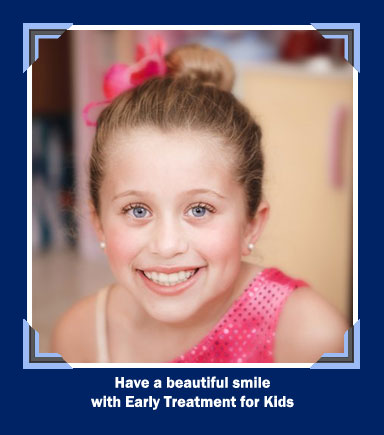Braces for Kids
Phase 1 Treatment at deFabrique Orthodontics
There are certain orthodontic and growth problems that benefit from early treatment procedures. These are: crowding, severe overbite (deep) bites, dysfunctional habits (thumb or finger sucking) and problems related to narrow jaw and airway. Treatment of these problems at an early age can produce benefits that might be less attainable or impossible to achieve at a later age. Such treatment usually requires a two phase treatment program.

A typical two phase treatment consists of a first phase of approximately six to fifteen months of active orthodontics when permanent and baby teeth are present. The corrections made in the first phase are retained with fixed space maintainers, Hawley bite plates or other removable retainers. Patients are then placed in our growth evaluation program. This is included in the phase one fee and includes quarterly office visits along with periodic panoramic x-rays and photographs. Phase two or comprehensive treatment is started once all the permanent teeth are in place.
Although the two phase treatment program does appear to be more involved, in reality, it can be a more effective way to treat the problems that are present at an early age. By expanding the jaws you eliminate airway problems, eliminate the need for extractions of permanent teeth, potential jaw surgery and actually shorten the time in full braces. To summarize, we will use a two phase treatment program, when it is required, because of what we are able to accomplish in altering the jaw structure and oral environment. A second phase is generally needed in 75% of the patients to finalize all the tooth positions and the bite.
When is the best time to consider phase 1 and phase 2 treatments?
Phase I Treatment usually starts while the child has most of his/her baby teeth and a few of his/her permanent teeth. This stage in development is usually about the age of 7. Phase II treatment usually occurs a number of years later. Usually we are waiting for 12-16 more permanent teeth to erupt before Phase II begins. This most commonly occurs at the age of 12 or 13. The goal of Phase II treatment is to achieve an ideal bite and to give you the smile you’ve always wanted.
What is Full or Comprehensive Orthodontic Treatment?
This is another name for orthodontic treatment in the permanent dentition at any age. It is more commonly used when a Phase I treatment was not performed.
Does everyone need a Phase I treatment?
Absolutely not! Dr. Angela deFabrique recommends that only certain bites require early intervention. All others can wait until most, if not all, their permanent teeth erupt. If your child does not need phase I treatment we will continue to monitor his/her dental and jaw growth at regular complimentary appointments until all of his/her permanent teeth have come in.
Can I wait on Phase I/Interceptive Orthodontic Treatment until my child is older?
This is not recommended. If your child needs phase I treatment, this usually means that he/she has a difficult problem that requires attention now. If no orthodontic action is taken, treatment may include extractions, oral surgery, increased time and costs.
What are extraction and non-extraction therapy, and what are the advantages and disadvantages of each?
Extraction therapy (also known as serial extractions) is a technique where some teeth are removed to make room for the other teeth in your child's mouth, usually ending in permanent teeth being removed. As many as 8 teeth (baby and permanent) may be removed.
Non-extraction therapy is where one expands a patient's jaw or shaves down some teeth to make everything fit. As non-extraction doctors, Cater and Galante prefer to expand the jaw to make room for all your child’s permanent teeth.











